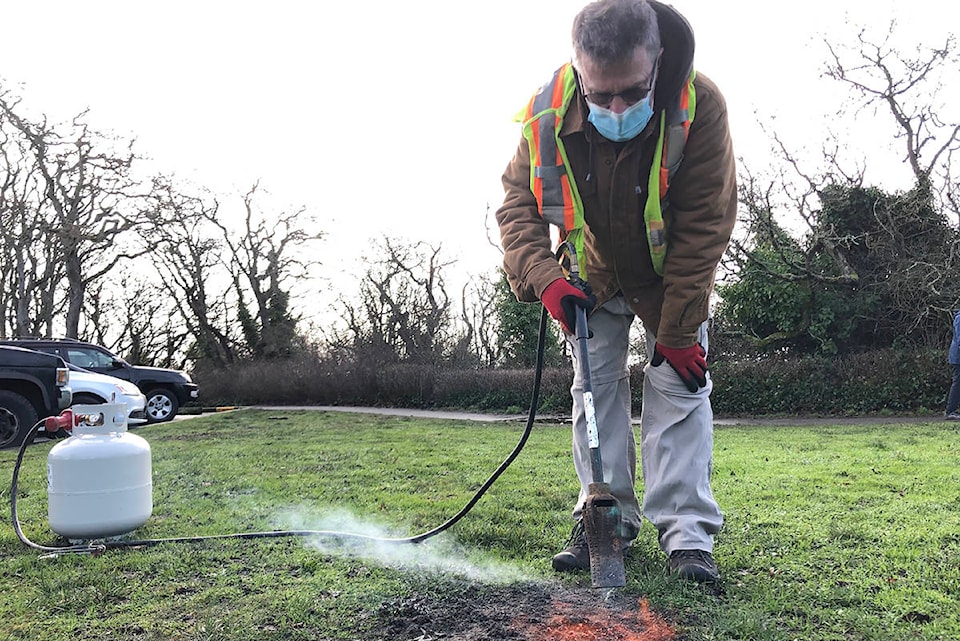With the flick of the flint, Wylie Thomas aims the propane torch at a spot on the Cattle Point grass.
Thomas burns a spot of grass that would otherwise look innocuous. It’s actually carpet burweed (soliva sessilis), an invasive plant threatening to suffocate the already at-risk species endemic to the rare maritime ecosystem of Cattle Point and Uplands Park.
The plant suppresses native species such as meadow foam and camas.
It’s burning season as @DistrictOakBay are burning the carpet burweed in Cattle Point & Uplands Park. pic.twitter.com/6QxseDqgpj
— Oak Bay News (@OakBayNews) December 18, 2020
Anyone walking through Uplands and Cattle Point right now will notice plenty of burned spots on the ground.
“Oak Bay had already identified carpet burweed when I got here in 2008 known about this but we are making a bigger effort to eradicate it,” said Thomas, a conservation biologist who manages the federally funded Habitat Restoration Stewardship project at Uplands and Cattle Point for Oak Bay.
READ ALSO: Feds designated Uplands Park a national heritage site, fund plant restoration
| Wylie Thomas holds Carpet burweed at Cattle Point. (Travis Paterson/News Staff) |
Thomas said carpet burweed was first observed in Canada in 1996 at Ruckle Provincial Park on Salt Spring Island, where it now encompasses an area of many thousand square metres.
“By 2005, it had spread to other parks in our region including Cattle Point, Beacon Hill Park and Jordan Regional Park, where several campsites have been closed down as a result,” he said.
It loves fields and rocky wastelands and is invading Garry oak associated wildflower meadows, which are one of the most endangered ecological communities in Canada, Thomas said.
Carpet burweed is also a problem for golf courses, noted Oak Bay manager of parks services, Chris Hyde Lay, who is hoping to keep it out of Henderson golf course and, even more importantly, out of the meadows of Uplands Park.
“We have increased the effort to eradicate it,” Hyde Lay said. “We want the public to know what we’re doing.”
“Through the Habitat Restoration Stewardship project, the federal government has given us considerable funding over the last many years to protect and restore the ecosystem for all the rare and endangered plants that grow in Uplands Park,” Hyde Lay said.
FROM THE ARCHIVE, 2011: Burweed bashing continues at Cattle Point
Burweed originates from South America. What makes it so challenging is how quickly it germinates, Thomas said, and that it germinates over winter when other plants are less active.
“They are annuals, and they grow to about the size of a dinner plate and it has sharp seeds. You can’t walk on it with bare feet,” Thomas said.
Come spring, golf courses end up with large brown spots where the burweed has died for the year.
Torches are effective because the plant has shallow roots. The flame also burns the seeds.
“You can’t use a torch on a dandelion or weeds with a deep taproot, they’ll come back, but it kills the burweed,” Hyde Lay said.
Another way to kill it is to let the grass grow around it.
“Originally, Oak Bay fenced off an area and let the grasses grow up to drown it out but the burweed had already hopped the fence,” Thomas said.
The biggest thing people can do to help minimize its spread is to stick to the paths in Cattle Point and Uplands.
reporter@oakbaynews.com
Do you have a story tip? Email: vnc.editorial@blackpress.ca.
Follow us on Twitter< and Instagram, and like us on Facebook.
